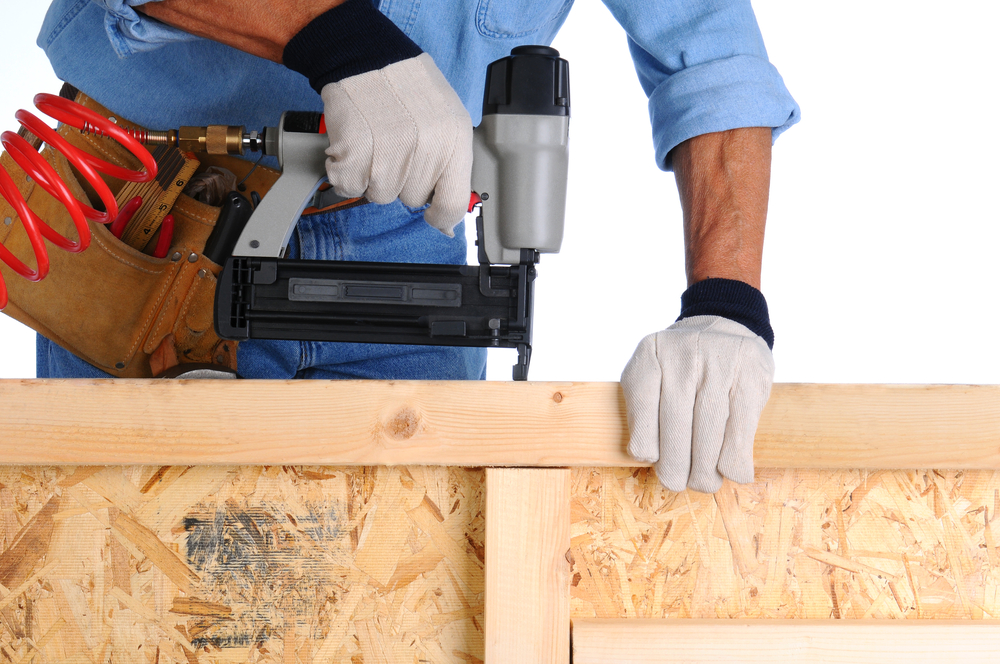
Nail gun injuries are common and often severe. In the last four years across the U.S., about 25% of on-the-job nail gun injuries caused employees to miss more than two weeks of work. In 14% of these injuries employees were off the job for more than a month. Proper training and practical safety steps can help employers and employees reduce nail gun risks and prevent injuries.
1 Begin with training
Employers should provide training on the safe handling of nail guns annually and for all new hires. Nail guns are driven by compressed air, a one-cylinder butane engine, battery power, or, in the case of powder-actuated tools, a small explosive charge. Training on powder-actuated tools is regulated by OSHA Standard 1926.302(e)(1). OSHA Standard 1926.21(b)(2) also requires employers to provide training on all potential job-related hazards. Examples of nail gun training topics may include:
- how the nail gun works;
- how to safely load and unload the nail gun;
- how to discharge nails;
- how to use the device’s safety features;
- how to position the nail gun;
- how to hold lumber or other materials during work; and
- how, if using a pneumatic nail gun, to operate the attached air compressor.
2 Use sequential nail guns
Sequential firing and contact firing nail guns differ in how the user operates the trigger and the safety tip on the gun’s nose. Contact firing (also known as bump firing) lets the user press the safety tip against a surface to fire nails continually. These types of multi-shot contact trigger nail guns can double-fire or accidentally discharge, causing injuries. The safer choice is to use a single-shot sequential trigger nail gun, which requires the user to press the gun’s safety tip to a surface, then pull the trigger to fire each nail. Studies suggest that the risk of nail gun injury doubles when using contact versus sequential trigger nail guns. Recent research also indicates that sequential nail guns only decrease productivity by about 1%.
3 Limit the use of nail guns in awkward positions
Nail guns are harder to control in tight spaces. If the job requires the worker to place the nail gun in an awkward position, consider using a hammer instead. Nailing above shoulder height, with the non-dominant hand, or in a tight space increases the chances of accidents. When the nail gun's tip does not make full contact with the workpiece, the hazard potential increases. Always keep the nail gun flush to the workpiece to prevent slipping and discharging a nail into the air. Nail guns can blow fragments off the nailing surface or fire a nail into electrical wires. Invest in a nail gun with teeth so that it grabs onto the workpiece to help prevent slippage.
4 Use nail guns only on intended materials
Using nail guns on any area with a weak or hard spot – like wood knots or metal framing hardware – could cause nails to ricochet or pass through the material. This can cause a nail to strike a worker. If the nail misses or breaks through the lumber, it can injure the worker’s non-dominant hand holding the workpiece. Workers should position themselves and their free hand out of the line of fire and watch for coworkers behind the nailing surface.
5 Never bypass, modify, or disable safety features
Enforce a strict policy that tampering with a nail gun is not allowed. Actions like removing the spring from the safety-contact tip or taping the trigger down so that pressing it is not needed, increases chances that the nail gun will fire accidentally.
6 Provide personal protective equipment
Always wear safety shoes to prevent toe and foot injuries. Employers should provide, at no cost to the employees, hardhats, high impact eye protection with a side shield (marked ANSI Z87.1), and earplugs or earmuffs for hearing protection.
7 Think safety
Fatigue can result in impaired judgment and injury. Never lower a nail gun from above by the hose, drag it by the hose, or pull on the hose. If the nail gun hose gets caught, find the problem, and release the hose. Stay alert and aware of the direction the nail gun is pointing. Treat a nail gun as if it were a loaded firearm. Never point a nail gun at someone, and keep fingers off the trigger when holding or carrying one.
8 Establish safe maintenance procedures
Remember to disconnect the nail gun before performing maintenance or clearing jams. Take broken or faulty nail guns out of service immediately.
For more information on nail gun safety, download OSHA’s Nail Gun Safety: A Guide for Construction Contractors.
